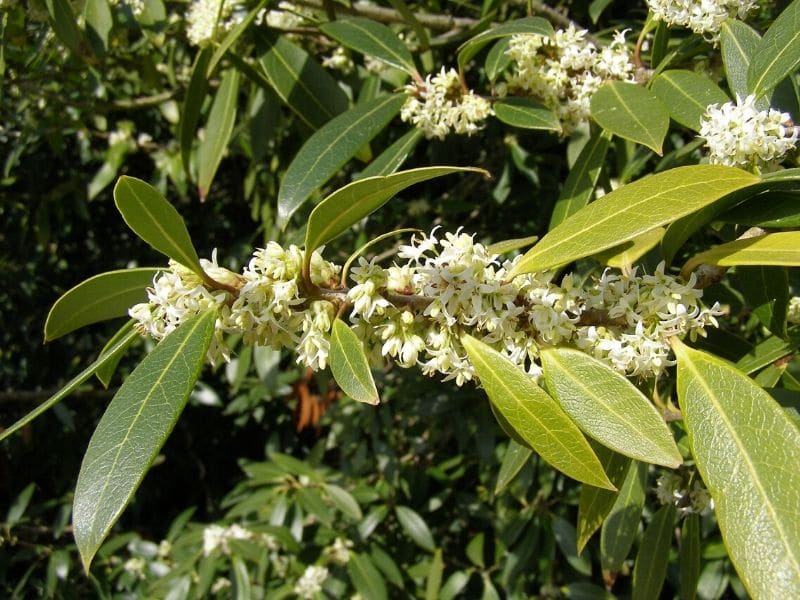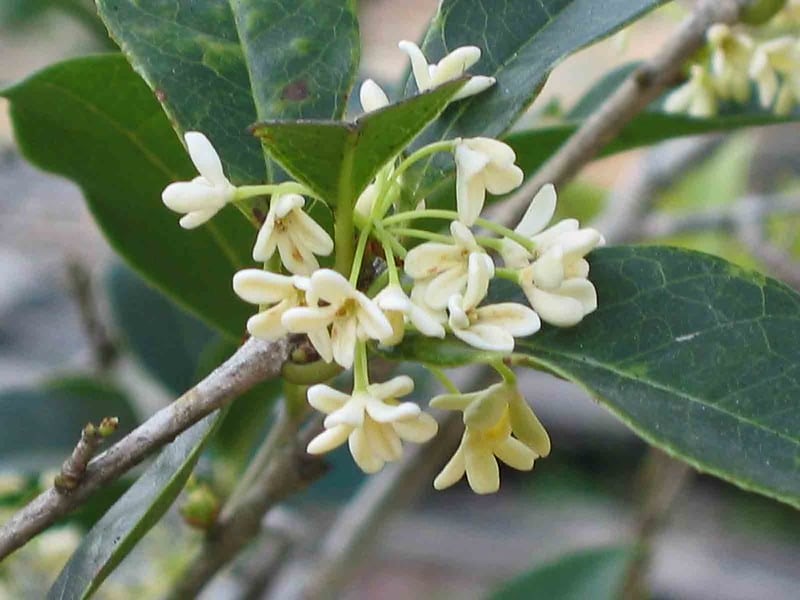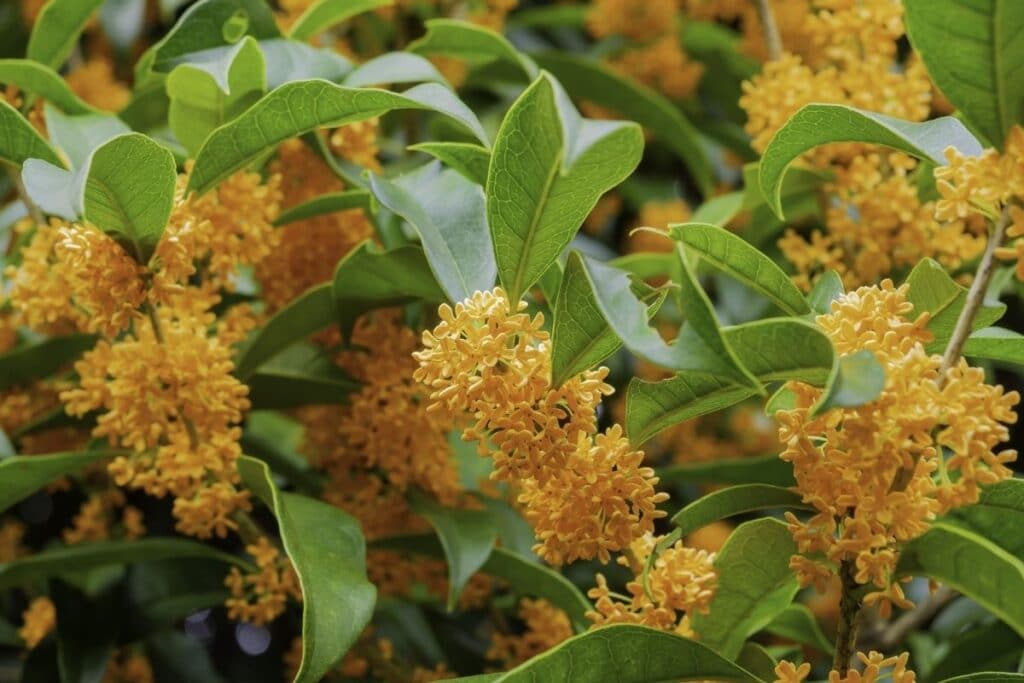Osmanthus (commonly known as Fragrant Tea Olive, sweet olive, sweet osmanthus or devilwood) is a group of flowering plants in the Oleaceae family that is native to eastern Asia.
It has small leaves (usually a cream-colored white or orange, though this can vary) that have four petals and are held in stalked clusters. The plant blooms from summer until fall and also produces small blue berries.
The rest of the plant has evergreen foliage that is glossy and dark. It grows to around 20 to 25 feet tall, but more often grows about 10 to 12 feet tall with an eight foot spread. An older plant will grow just as wide as it is tall, developing a characteristic vase shape and numerous main trunks that grow close to the ground.
Varieties of Osmanthus You Can Grow

There are several varieties of osmanthus to be aware of, each of which holds its own unique beauty and symbolism. These are some of the most common osmanthus varieties, although dozens of hybrids and cultivars have been developed.
In fact, more than 29 cultivars of osmanthus have been developed, with colors varying between white, yellow, red, and gold.
Osmanthus fragrans
Also known as the sweet tea shrub or the fragrant olive, this kind of osmanthus is one of the most popular garden flowering plants in all of China. It has very fragrant flowers and can grow to ten feet tall with several trunks.

Each evergreen shrub will produce oval leaves roughly four inches long. These are leathery and toothed. Flowers of this plant are often used to produce extracts that can be used in teas as well as for hair ornaments. It produces white or orange gold flowers depending on the individual cultivar.
Osmanthus heterophyllus ‘Sasaba’
This variety of osmanthus, known as the holly tea olive shrub, can grow up to eight feet tall. It has glossy, dark green leaves shaped like triangles. Each is deeply cut with sharp tips and cream light veins. The fruits are very similar to the more common edible olives you likely know about. It produces fragrant flowers that appear in late winter.
Osmanthus x fortunei, ‘variegatus’
This kind of osmanthus, also known as fortune’s osmanthus, was named after Scottish botanist Robert Fortune. It has leathery dark green foliage that looks much like leather along with an overwhelmingly strong fragrance. It, too, produces several trunks that grow close to the ground and have top branches filled with tiny leaves and sharp teeth.
Osmanthus heterophyllus ‘Rotundifolius’
Another rare species of osmanthus, this one grows to about five feet tall and five feet wide, producing tips that are about one inch long and wide. It is a compact form of osmanthus that produces multiple long branches.
Osmanthus delavayi
Osmanthus delavayi, or the delavay osmanthus, can grow to ten feet tall and has tiny leaves with profound thorns. It produces fragrant white flowers and is named after Jean Marie Delavay, a French Jesuit missionary plant collector.

How to Care for Osmanthus Plant
Here’s how to care for this common Chinese flower:
Watering
You will need to water your osmanthus shrub regularly until it is well-established and starts to grow. After the first season, you’ll only have to water during prolonged dry spells.
Soil Type and Planting
Osmanthus is an easy to grow plant that can be grown in just about any soil type. It can tolerate acidic to neutral soils as long as there is good drainage. If you wish to form a screen or hedge with your osmanthus plants, just space them four to six feet apart when you plant. Alternatively, you can clip the plants to form a dense canopy.
You can plant osmanthus at any time, but the best time is in the fall, which will encourage rapid root development throughout the winter. However, you can plant it all year as long as you pay attention to watering when planting in spring or summer.
Light
Grow your osmanthus in a location with partial shade or full sun. it will grow more densely in full sun than it will in shade, but any osmanthus types that are variegated will bleach out a bit in full sun, particularly if you are growing them in warm climates. If that’s the case, you will want to provide them with a bit of afternoon shade.
Temperature
Osmanthus is cold hardy to zones 8-9. It is often grown in containers since it grows slowly and in warmer climates. Consider planting osmanthus where its delightful fragrance can be enjoyed, either by a window, door, or near outdoor sitting areas.
One thing that is important to note is that osmanthus does not like cold wind. It can negatively impact the plant at all times, but especially when it is blooming. When you choose your planting location, shelter it from the wind whenever possible.
Fertilizer and Other Care Requirements
Fertilizing should be done every year or every season, ideally in the fall when the plant has started to go dormant. Use a general purpose fertilizer and spread it over the root zone before watering. Compost will also work if you wish to apply slow-release fertilizer.
Some people recommend spreading fireplaces ashes near the base of the tree, particularly during the winter. This is said to increase blooming in the early spring, likely because it raises the acidity of the soil.
Osmanthus shrubs flower on old wood and are unique from other types of shrubs in that they do not need to be pruned often. Left unpruned, osmanthus shrubs will actually produce more flowers.
However, you may find it necessary to prune if your tree has suffered from some damage. When you do prune, remove only a few branches here and there rather than cutting indiscriminately, as excessive pruning can prevent the tree from blooming for several years. One popular style of pruning this tree is just removing the low, lateral branches to form a multi-trunked tree.
Common Pests and Diseases for Osmanthus
For the most part, osmanthus is a sturdy, hardy plant that resists most kinds of diseases and pests. You will have to watch out for mealy bugs, but even they aren’t common. Other issues to watch out for are scale and nematodes. Root rot and mushrooms can occasionally become problematic if the soil is kept wet.
Again, osmanthus is very drought-tolerant, so keeping the soil dry rather than overly wet is recommended. You’ll avoid many common fungal issues and you won’t have to worry about overwatering.
FAQs
Why is osmanthus tea expensive?
Osmanthus tea can be expensive due to the labor-intensive process of hand-picking the delicate flowers, which bloom for a short period in autumn. Additionally, the flowers are prized for their intense fragrance and unique flavor, contributing to the tea’s overall value.
What is osmanthus in Chinese culture?
In Chinese culture, osmanthus symbolizes good fortune, prosperity, and happiness. The fragrant flowers are associated with love and romance, making them a popular choice for special celebrations and events.
Up next: Osmanthus Flower Meaning and Symbolism
*image by depositphotos.com/BestMe







